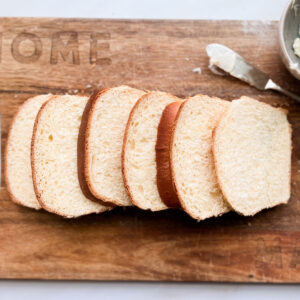
Super Soft White Sandwich Bread
This super soft sandwich bread will be your one and only white bread recipe! Using the Tangzhong method makes this bread bake up extra soft, and keeps it fresher longer! Make it with instant yeast, or see the option for using sourdough starter. This recipe makes 2, 8-inch loaves. Total dough weight around 1100g.
Equipment
Ingredients
Tangzhong
- ⅓ cup water
- ⅓ cup milk whole or 2%
- 3 Tablespoons bread flour
Dough
- The tangzhong mixture cooled to lukewarm temperature ~85°F/30°C
- ¾ cup milk whole or 2%, lukewarm ~85°F/30°C
- ⅓ cup granulated sugar
- 2 teaspoons fine sea salt
- 2 Tablespoons instant yeast
- 2 large eggs room temperature
- 4 ¼ cups bread flour ~13%protein
- 6 Tablespoons unsalted butter softened
Instructions
Make the Tangzhong
- Add all the ingredients for the tangzhong to a small saucepan. Before turning on the heat, whisk the ingredients together, smoothing out any lumps of flour. Once combined, place the saucepan on medium low heat, stirring constantly until it thickens to a paste-like mixture (like making a rue), about 5 minutes.
- Remove from the heat and transfer the tangzhong into a heat-safe bowl. Set aside to cool to a lukewarm temperature, about 85°F/30°C. Pro tip: Spread the hot tangzhong on the bottom of your mixer bowl - it will cool down faster.
Mix the dough:
- To the bowl of a stand mixer, combine the tangzhong mixture, milk, sugar, salt, instant yeast, 2 eggs and about half of the flour. On low speed, mix with the dough hook attachment until combined and smooth. Gradually add the remaining half of the flour. Continue to mix until fully combined. The dough will be thick and slightly dense.
- While on low speed, add the softened butter, one tablespoon at a time. Allow butter to fully incorporate between additions. This could take up to 5 minutes. While adding the butter, the dough will begin to smooth out and become softer.
- Knead dough for 10-15 minutes on low speed, until it forms a cohesive, smooth ball of dough. It should come to window pane (check blog post for tips on the windowpane test). At this point, the dough should feel very soft and elastic. It will become easier to handle after it rises during bulk fermentation.
Bulk Fermentation:
- Place the dough into a larger, greased bowl. Cover with a plastic bowl cover or clean kitchen towel. Let rise until doubled in size, about 60-90 minutes.
Shaping:
- Grease loaf pans with nonstick spray and set aside.
- Turn dough onto a lightly floured work surface and deflate. Divide dough into 2 equal pieces, each weighing about 525g.
- Working with one piece of dough at a time, gently stretch the dough, with your hands, to a rectangle about 10-inches by 12 inches. Be careful as to not tear the dough. Fold the top third over towards the center. Fold the left and right sides in towards the center, meeting in the middle. Gently press the vertical seam together. Roll the dough up, starting at the end closest to you. With the seam side down, drag the loaf towards you, tightening the outer layer of the bread and sealing the bottom seam shut. (see blog post for shaping pictures)
- Place each loaf in the loaf pan with the seam side down. Cover with a clean kitchen towel.
Final Proof:
- Let the bread rise in a warm area of your kitchen, around 40-60 minutes until risen about 50% in size.
- During the rise time, begin preheating oven to 350°F. Place the oven rack just below the center position.
Baking:
- Before baking, use the poke test to make sure the dough has risen enough - Gently poke the side of the dough with your finger. If it leaves an indentation, it is time to bake. (see blog post for more about the poke test)
- Brush egg wash on top of the loaves and bake for 30-35 minutes. It should be golden brown and the internal temperature should be at least 195°F.
- Place the loaves on a wire rack, leaving them in the pans for 20 minutes before removing. Allow to cool completely on the wire rack before slicing.
- Store leftover bread in a bread bag for up to one week. Or store in the freezer for up to 3 months.
Notes
- Sourdough option: If replacing yeast with 100% hydration sourdough starter, use 1/2 cup (120g) ripe starter. Ripe starter is active and bubbly and just about ready to be fed. Be sure to reduce the bread flour and milk in the dough recipe to compensate for the amount you are adding with the starter. If using a 100% hydration starter, reduce the flour by 60g and the milk by 60ml. Rise times will be longer, depending on the activity of your starter and the climate in your kitchen.
- Make ahead option: When placing dough in container for Bulk Fermentation, you can refrigerate it for up to 24 hours before shaping. Placing in the refrigerator will slow down the fermentation (rise). The dough will continue to rise in the refrigerator, but at a slower rate. When ready to bake, remove dough from refrigerator and let rest in the container, at room temperature, for 30 minutes. Divide dough, shape and place in bread pans to rise. Depending on how warm your kitchen is, chilled dough may take up to an extra hour to rise before baking.
Nutrition
Serving: 1sliceCalories: 133kcalCarbohydrates: 20gProtein: 4gFat: 4gSaturated Fat: 2gPolyunsaturated Fat: 0.4gMonounsaturated Fat: 1gTrans Fat: 0.1gCholesterol: 24mgSodium: 205mgPotassium: 49mgFiber: 1gSugar: 3gVitamin A: 128IUVitamin C: 0.001mgCalcium: 21mgIron: 0.3mg
Did you make this recipe?Tag @thatbreadlady on Instagram and hashtag it #thatbreadlady